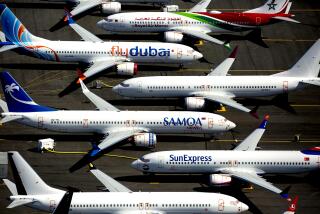Boeing unveils a 747 that’s bigger, more fuel efficient
- Share via
Aerospace giant Boeing Co. unveiled a larger, quieter, and more fuel-efficient version of its 747 jumbo jet in front of a crowd of 10,000 last weekend in Everett, Wash., where the planes are assembled.
Ever since the Boeing passenger jet made its first commercial flight more than 40 years ago, the plane has been an icon of the aviation industry.
There are a total of 107 orders for the new plane, which has both passenger and freight versions. Only 33 of the orders are for passengers.
The mammoth plane, dubbed 747-8 Intercontinental, was painted in a retro-looking combination of red, orange and white, a departure from Boeing’s standard blue and white.
“The new color palette honors many key Boeing customers whose cultures recognize these colors as symbols of prosperity and good luck,” the company said in a statement.
Designed to carry between 400 and 500 passengers, the plane is about 250 feet long. That is 18 feet longer than the current 747 and carries more passengers.
It also has an overhauled interior design that borrows from Boeing’s upcoming next-generation passenger jet, the 787 Dreamliner. The 787 is smaller than the 747 and seats up to 290 people. It is currently being flight-tested.
The Chicago company said the interior design includes “a new curved, upswept architecture giving passengers a greater feeling of space and comfort.”
Boeing’s selling point to carriers is that the 747-8 offers 16% better fuel economy and 16% less carbon emissions per passenger than its predecessor. Flight testing is expected to start next month.
“The new 747-8 Intercontinental features the latest in innovative technologies — applying many of the breakthroughs also found on the 787 Dreamliner,” Boeing Chief Executive Jim Albaugh said in a statement. “We think our customers will value the low operating costs and passengers will enjoy the comfort of the striking new interior.”
The 747’s cavernous cabin is built in Hawthorne by Triumph Aerostructures-Vought Commercial Division. Twice a week, the company ships fuselage panels and sends them along in three custom, oversized railroad cars to Boeing’s assembly plant in Everett. The site has produced the fuselage panels for every 747 that has taken to the skies — including Air Force One — since the aircraft program began in 1966.
More to Read
Inside the business of entertainment
The Wide Shot brings you news, analysis and insights on everything from streaming wars to production — and what it all means for the future.
You may occasionally receive promotional content from the Los Angeles Times.











